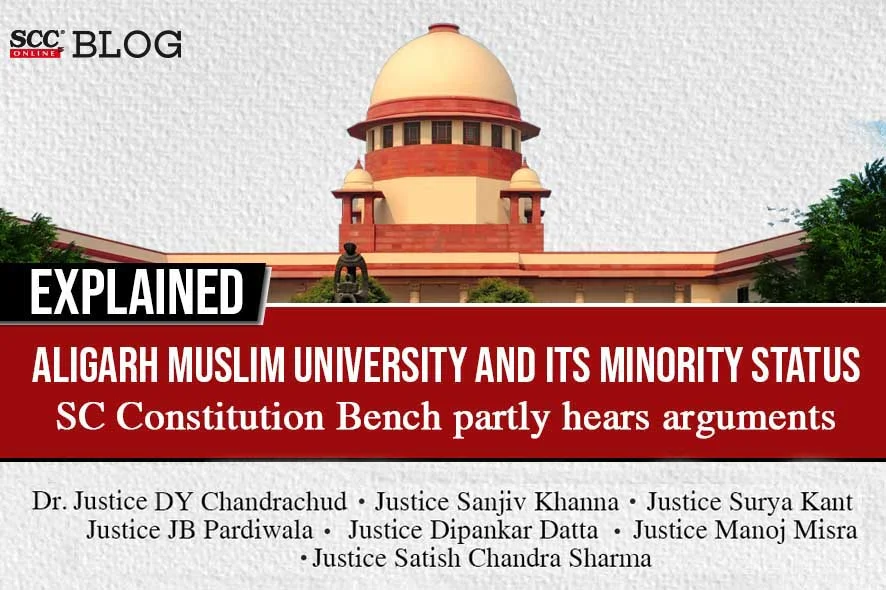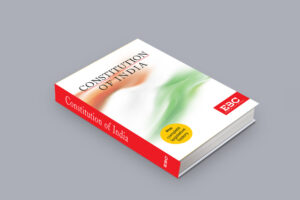Supreme Court: The Seven-Judge Constitution Bench comprising of Dr. DY Chandrachud, CJ., Sanjiv Khanna, Surya Kant, JB Pardiwala, Dipankar Datta, Manoj Misra and Satish Chandra Sharma, JJ. began hearing of an appeal against Allahabad High Court’s Order in Naresh Agarwal (Dr.) v. Union of India, 2005 SCC OnLine All 1705, whereby, Aligarh Muslim University’s (‘AMU’) action of 50 percent seat reservation in postgraduate medical courses for Muslim candidates by claiming it to be a minority institution, was struck down and held that AMU cannot have an exclusive reservation because it is not a minority institution.
Background
S. Azeez Basha v. Union of India, (1968) 1 SCR 833
The constitutionality of the Aligarh Muslim University (Amendment) Act, 1951, whereby, non-Muslims could also be members of the Court of the University, however, the Court would still remain the supreme governing body of the University, and the Aligarh Muslim University (Amendment) Act, 1965, whereby, the University Court no longer remained the supreme governing body and could no longer exercise the powers conferred on it by Section 23(2) and (3) of the Aligarh Muslim University Act, 1920 (‘1920 Act’) was brought into challenge.
It Court held that AMU was created by an Act of Parliament i.e., the 1920 Act is not a minority institution so as to be covered under Article 30 of the Constitution of India. It was observed that the nucleus of the Aligarh University was the M.A.O. College, but the conversion of that College into a University was however not by the Muslim minority, it took place by virtue of the 1920 Act which was passed by the Central legislature.
Aligarh Muslim University Amendment Act, 1981
To nullify the effect of Azeez Basha (supra), the Aligarh Muslim University Amendment Act, 1981 was brought into effect. The 1981 Act substituted the Sections of the 1920 Act which formed the basis for the verdict in Azeez Basha (supra) and the definition of the term ‘University’ was amended to mean an “educational institution of their choice established by the Muslims of India, which originated as the Muhammadan Anglo-Oriental College, Aligarh and which was subsequently incorporated as the Aligarh Muslim University”.
Naresh Agarwal (Dr.) v. Union of India, 2005 SCC OnLine All 1705
The decision of the Admission Committee of the AMU in 2005 that the total seats available for Post Graduate Medical Courses be reserved to 50 percent for the Muslim candidates was challenged. The Court held that AMU is not a minority institution within the meaning of Article 30 of the Constitution, therefore, the University cannot provide any reservation in respect of the students belonging to a particular religious community. Accordingly, it was held that the decision in Azeez Basha (supra) still holds good even after the Aligarh Muslim University Amendment Act, 1981.
Aligarh Muslim University v. Malay Shukla, 2006 SCC OnLine All 2207
Whether AMU is a minority Institution?
The Court held that the AMU, a body corporate, came into existence only by Act of legislature. The Court also said that it is true that 1920 Act was passed as a result of the efforts of the Muslim minority, however, the then Government also had its significant role in the establishment of the University. Therefore, the AMU cannot be a minority institution within the meaning of Article 30 of the Constitution.
Reference to 7-Judge Bench
The High Court’s decision in Naresh Agarwal (supra) was challenged before the Court in Aligarh Muslim University v. Naresh Agarwal, (2020) 13 SCC 737. The 3-Judge Bench of the then CJI Ranjan Gogoi, L. Nageswara Rao and Sanjiv Khanna, JJ. noted that the issue in S. Azeez Basha (supra) was referred to a seven-Judge Bench by an order of the Court in Anjuman-e-Rahmania v. District Inspector of School.1 The issues that were formulated in these references was “What are the indicia for treating an educational institution as a minority educational institution? Would an institution be regarded as a minority educational institution because it was established by a person or persons belonging to a religious or linguistic minority or its being administered by a person or persons belonging to a religious or linguistic minority?” A similar question was heard by the Court in T.M.A. Pai Foundation v. State of Karnataka, (2002) 8 SCC 481, however, it remained unanswered. Therefore, the Bench noted that the correctness of the decision taken in S. Azeez Basha (supra), which was called into question, remained undetermined.
Therefore, taking into regard the background, when the precise question was already referred to a seven-Judge Bench and was, however, not answered in P.A. Inamdar v. State of Maharashtra, (2005) 6 SCC 537, the Bench referred the matter to a Seven Judges Bench.
The ongoing Trial
The matter was placed before the Seven-Judge Constitution Bench comprising of Dr. DY Chandrachud, CJ., Sanjiv Khanna, Surya Kant, JB Pardiwala, Dipankar Datta, Manoj Misra and Satish Chandra Sharma, JJ. The hearing began on 09-01-2024. The Bench on its day 3 of the hearing said that Article 30 of the Constitution does not mandate that administration has to be by minority itself, but it only contemplates and recognises the right of choice, the discretion given to minorities to administer in a manner which they deem appropriate.
[Aligarh Muslim University v. Naresh Agarwal, Civil Appeal No. 2286/2006]
Buy Constitution of India HERE
1. Writ Petition (Civil) Nos. 54-57 of 1981.








